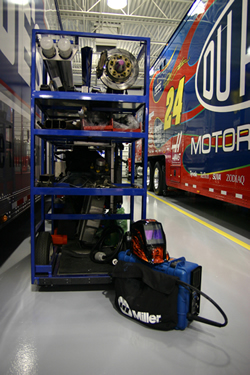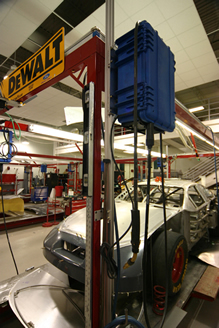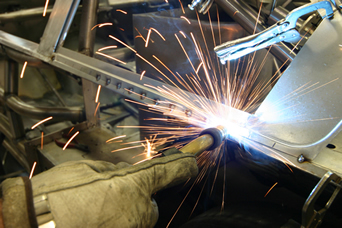Nextel Cup teams are continuously looking for ways to cut the weight on their transporters or save space in the shop. So when Miller came out with a unique all-in-one MIG welder that weighed only 45-lbs., including the internal gas bottle, it drew some considerable attention from some of NASCAR’s most prestigious racing organizations. Hendrick Motorsports, Roush Racing and Dale Earnhardt, Inc. (DEI) have incorporated the Millermatic® Passport™ into their racing operations for use in a number of different ways. Whether in the shop or on a “crash cart” at the track, the Millermatic Passport is the industry’s first ultra-portable MIG welder that allows these teams to save space while enhancing arc performance and improving weld quality.
Packing Light at Hendrick Motorsports
On average, it takes two days for a NASCAR team to pack for a race. It’s no small task for Hendricks Motorsports transport driver Kirk George as he juggles tools and parts in a never-ending battle to reduce the weight on his transporter. “We have to restock and reload everything each week,” says George. “Sometimes equipment and parts need to be sent by an external company because we are overweight and can’t fit everything in.” Every transporter has a legal weight limit of 80,000 lbs. while traveling on the Interstate. NASCAR fabricators and transport drivers value lighter tools that retain quality and performance. For the Hendrick team, the Millermatic Passport exceeds these standards.
“By switching to the Passport, we took nearly 100-lbs. off the gross weight of the truck,” comments Ron Malec, car chief, Hendrick Motorsports. The Passport’s compact design enables the Hendrick team to fit more replacement racecar parts on their transporters without increasing the gross weight of the trailer. “Because the Passport takes up less room, we can get more springs, sway bars and other pieces of equipment on the transporter,” continues Malec. “Having more parts on hand means that we are better prepared to respond to an accident during a race.” Previously, Hendrick fabricators used several 75-lb Millermatic® 175s that required separate shielding gas cylinders.
In addition to saving weight, the Hendrick fabrication crew devised a unique solution for their welding repair needs at the racetrack. Fabricators use a device, called the “crash cart,” to quickly transport the most vital replacement components, tools and equipment to the scene of an accident or a crash (see Figure 1). For their welding repair needs, the Hendrick fabrication crew keeps the compact Millermatic Passport on every crash cart.
 |
| Fig. 1. For quick repairs, Hendrick fabricators use a “crash cart” to quickly deploy the Passport to the scene of a crash. |
Unlike Hendrick’s previous Millermatic 175s with separate gas cylinders, the Passport is a completely self-contained MIG welder. The Passport’s internal gas cylinder holds 12-oz. of CO2 and provides up to 25 minutes of welding with .030-diameter mild steel solid wire.
Quick Repairs Help Win the Race
Hendrick fabricators encounter a variety of damage incurred during a race. Jimmie Johnson (#48) experienced a crash during a Talladega race, tearing the nose off his car. Back in the pits, four crew members removed the mangled tubing and welded a whole new assembly back on within five minutes allowing Johnson to continue on with the race. The front-end, the most commonly damaged portion of the car, requires a fabricator to weld a wide range of material thicknesses. For example, the fender brace tube measures between .040 and .060, while frame horns measure as thick as .120. The fabrication crew needs to be able to repair damaged components as quickly as possible, with the crew’s time measured in number of “laps down,” or the number of laps that have surpassed since the car has entered the pit area. With the ability to weld on materials as thin as 24-gauge to 3/16-inches thick, the Passport can handle virtually any racecar welding repair application.
The Passport provides excellent welding performance for quick repairs both on the racetrack and in the shop. Because the Passport is an inverter-based welder, it produces stable, high-quality arc characteristics with excellent arc starts. The Passport’s ability to initiate and maintain a stable arc means Hendrick fabricators can weld and burn through painted parts at the track for faster repairs.
At the racetrack, teams typically use a generator-supplied power, but depending on the racetrack, primary power is occasionally available in each team’s garage area. Because the primary power type at the garage is often unpredictable, the fabrication team takes advantage of the Passport’s MVP™ (multi-voltage plug), which allows them to connect to 115- or 230V power receptacles without the use of any tools. Fabricators simply choose the plug that fits the receptacle, connect it to the power cord and begin welding. In addition, the Passport’s Auto-Line™ technology automatically connects to 115- or 230 VAC, single-phase power without the hassle of removing the cover to relink the power source, providing state-of-the-art maximum primary power flexibility. Auto-line allows fabricators to plug in anywhere, any time and as a result, increases the crew’s response time to crashes.
By using the Passport, Hendrick fabricators easily weld on thick components (such as lead and frame rails) down to metal as thin as 24-gauge sheet metal for body repairs with equally impressive results. The Passport features a preset “run-in” circuit, which temporarily reduces the wire feed speed from the actual preset wire setting. The run-in feature allows the “cold” wire to first establish the arc. Then the Passport’s auto preset speed engages to provide crisp, clean arc starts with minimal spatter (see Side Bar 1).
Driving the Welds at Dale Earnhardt, Inc.
Likewise, fabricators at Dale Earnhardt, Inc. (DEI), use the Passport to weld the body panels, known as “skinning.” For skinning a car, DEI fabricators use the Passport to produce thousands of tack welds spaced approximately 1- to 2-inches apart on the body panels. Fabricators must produce a full penetration tack weld with only one pull of the MIG gun trigger, without burning through or warping the work piece. “By using the Passport to weld body panels, I get a good weld on the first trigger pull, virtually every time,” says Michael Olesnevich, fabricator, Dale Earnhardt, Inc.
To connect the 24-gauge body panels to the .120 structural tubing, DEI fabricators run a hotter arc with a slower wire feed speed to ensure full penetration without burning through the sheet metal (see Fig 2). “The Passport doesn’t cause hot spots that would get the tubing excessively hot to the point where its been crystallized,” says Olesnevich. An overheated tube or structural component becomes brittle and weaker due to the altered molecular structure.
 |
| Fig. 2. DEI fabricator Michael Olsnevich uses the Passport to weld racecar body panels. |
DEI fabricators also use the Passport to weld on heavier mild steel components such as motor mounts that measure 1/4-inch thick. The welds on the motor mounts of the vehicle must fully penetrate the base metal to achieve structural integrity. A “cold weld” (a weld with little or no penetration) poses a major safety issue for the driver because the weld would simply not be strong enough to remain intact during a crash.
DEI fabricators also rely on the Bernard® Q™-Gun and Centerfire™ consumables to achieve superior welding results. “It’s super easy to change the tips on the Q-Gun, and the Centerfire tips lasts much longer than the previous brand,” comments Olesnevich. The Q-Gun’s rotatable neck allows fabricators to weld in tight areas, such as underneath the dashboard.
DEI fabricators value the Passport’s lightweight and highly portable design to get drivers like Dale Earnhardt, Jr. (#8) across the finish line and into the winner’s circle. Fabricators estimate that the Passport weighs as much as 50-percent less than their previous unit and allows them to carry additional equipment, such as a TIG welder to the race.
Performance Welding Racks at Roush
At Roush Racing, with drivers such as Matt Kenseth (#17) and Mark Martin (#6), the Passport plays an important role in the chassis and body shop. Roush owns dozens of teams, and often has up to 80 racecars in just one of their many shops. With the large number of pieces of equipment, fabricators, mechanics, parts and racecars in one area, space savings and reduced clutter is a major priority for Al Allen, body fabrication manager, Roush Racing. Roush previously used Millermatic 175s and 210s for chassis and body fabrication but replaced the machines with 24 lightweight and compact Millermatic Passports. “One of the biggest reasons we chose the Passport was because of its inverter based technology and its lightweight, a highly portable design,” explains Allen. With a flip of a switch, Roush fabricators can select between the internal CO2 gas supply (when they’re on the move) and bulk supply when they’re in the shop.
Roush fabricates its racecars in special “body hanging bays,” where lasers center the body panels and the chassis to ensure perfect symmetry. Allen devised a unique way of saving floor space by directly mounting the Passports on to the overhead corners in each bay, so that 12 machines can run off of one large shielding gas bottle (see Figure 3). This allows multiple fabricators to work on one car simultaneously without having to worry about the machines or cables taking up valuable floor space.
 |
| Fig. 3. To save space in their shop, Roush fabricators mounted 4 Passports directly onto their “body hanging bay.” |
Roush uses the Passport on mild steel as thin as 24-gauge to 1/8-inch thick. To prevent the body panels from warping, fabricators produce thousands of tack welds with identical penetration and bead sizes (see Figure 4). “We turn up the amperage on the Passport, to make a good, hot and small tack,” explains Allen.
Like DEI and Hendrick, Roush fabricators also rely on the Bernard Q-Gun and Centerfire consumables to produce excellent welding results. Compared to their previous MIG guns, the Bernard Q-Gun feeds wire more smoothly, is more durable and is easier to maintain. With their previous MIG gun, the wire would frequently misfeed and kink within the liner. “Welding with the Bernard Q-Gun was like night and day compared to our previous MIG gun,” says Allen. “With the Q-Gun and Centerfire, fabricators also use significantly less contact tips which means they spend more time welding.”
NASCAR is truly a team sport—everyone plays an integral role in successes and failures. Today’s professional racing industry represents the latest in cutting edge technology, which means every tool, every computer and bolt-on component has been tested, proven and leveraged for one sole purpose: to get the car across the finish line first and hold it together for the victory lap. Checkered flags aside, the tools of the trade have evolved, advancing this “cutting edge toolbox” to new heights. However, with all these new tools, space savings and portability are increasingly valuable to NASCAR fabrication teams. That’s why they’re turning to the compact, yet powerful Millermatic Passport to help get their drivers to the winner’s circle.
 |
| Fig. 4. To produce thousands identical tack welds on a single racecar, Roush fabricators rely on the Millermatic Passport and Bernard Q-Gun with Centerfire welding consumables. |
Side Bar Story
To provide maximum portability, the Millermatic® Passport™ uses inverter-based technology, enabling control arc over
characteristics thousands of times faster than larger, traditional transformers. An inverter is an electrical component that converts electricity between AC and DC up to 50 thousand times per second. As a result, the Passport delivers positive arc starts without popping and minimal spatter while welding.
For maximum location flexibility, the Passport features Miller’s exclusive MVP™ (multi-voltage plug) and Auto-Line™ Power Management Technology. This allows the Passport to connect to 115 and 230 V power just by choosing the right plug and without removing the cover to relink the power source. Auto-Line allows the Passport to produce a rock-steady arc—even through primary power fluctuations. With a flip of a switch, operators can select between the internal CO2 gas supply (when the user is on the move) and bulk supply when the user is in the shop and needs mixed gas (such as “75/25” or a “tri-mix” for welding stainless steel). Using the Passport’s arc control button, operators can select between a crisp-arc characteristic suited for welding mild steel or a softer arc characteristic that provides better wet-out on stainless steel.
Side Bar Story
Back at their shop, the Hendrick fabrication team relies on the Bernard® Q™-Gun and Centerfire™ consumables to deliver high quality welds. Because fabricators are under constant pressure to meet deadlines, minimizing welding rework is always a concern.
“Since we’ve started using the Q-Gun, I’ve noticed that arc starts are much easier—probably 75-percent better—and they are also a lot more comfortable to use,” explains Malec. Centerfire series contact tips “Drop-In” the gas diffuser and are locked in place by tightening the nozzle. These “Drop-In” contact tips without threads do not require tools to change, are quicker to replace after burn back and, when coupled with the correct nozzle, stay fixed either flush with the end of the nozzle, at 1/8- or ¼-inch recess. Their large diameter tip bases and tapered seats increase electrical conductivity and heat transfer.
With their previous MIG guns, there was a space between the wire and the contact tip. As a result, fabricators actually purchased smaller diameter contact tips and drilled a new hole to better match the contact tip diameter to the wire diameter. This meant that fabricators were spending less time welding on the racecars because they were busy modifying their contact tips.
Unlike many of the smaller NASCAR teams, Hendrick Motorsports chooses to build their race car chassis and components from the ground up, which gives them ultimate control over customization and allows them to minimize defects and variables that would be otherwise found in pre-built chassis offered by outside suppliers. Building chassis in-house allows fabricators to make specific adjustments to the chassis based on feedback from engineering and research results.
Hendrick Motorsports also uses several of Miller's TIG products throughout its facility, including the Syncrowave®, Maxstar® and Dynasty® TIG welding machines, along with Weldcraft's WP-20 TIG torch. “Every fabricator in the shop, including myself, really likes the WP-20 torch. The WP-20’s small size allows us to weld in really tight places and I’ve yet to see a manufacturer who makes a better TIG torch,” explains Ron Malec, car chief, Hendrick Motorsports.